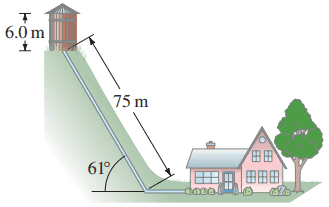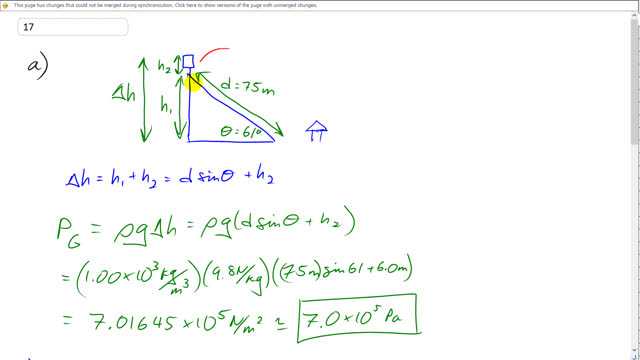
A house at the bottom of a hill is fed by a full tank of water 6.0 m deep and connected to the house by a pipe that is 75 m long at an angle of from the horizontal (Fig. 10–49).
- Determine the water gauge pressure at the house.
- How high could the water shoot if it came vertically out of a broken pipe in front of the house?


In order to watch this solution you need to have a subscription.
This is Giancoli Answers with Mr. Dychko. The pressure head at the faucet in the house equals a vertical height between the faucet and the top of the tank. So knowing that this is 75 meters at an angle of 61 degrees, we can use that to figure out h 1 and then add the height of the tank, h 2, to that to get the total pressure head of the faucet which is Δh. So h 1 plus h 2 so that's dsin Θ this giving us the opposite leg of this triangle which is h 1 and then add to that h 2. So the gauge pressure at the faucet is gonna be the density of water times g times this pressure head so that's gonna be ρg times dsin Θ plus h 2. So that's 1 times 10 to the 3 kilograms per cubic meter times 9.8 newtons per kilogram times 75 meters times sin 61 plus 6.0 meters which gives about 7.0 times 10 to the 5 pascals. And then to figure out how high this water would shoot out of the faucet that's down here, we can think about the Bernoulli equation and it says that the pressure at one point plus one-half density of fluid times its velocity there squared plus its, you know, think of it as potential energy ρg times its height there equals the pressure plus the kinetic plus the potential energy of the fluid at some other point. So we'll compare the top of the fluid flow to the bottom so the fluid starts here and then it shoots up to some height up here. So at the top, it's gonna have zero velocity up here— this is at the top— and so this kinetic term becomes zero, v top is zero. And the pressure up there will be atmospheric pressure and it will have ρg and then y subscript T for top here. And then Bernoulli's equation also holds that the opening of the faucet as well and that the opening pressure is also atmospheric pressure; if we were to put a cap on the hose, then there would be this gauge pressure that we calculated there but once the cap is open and the water is pouring out just at the exit of the faucet, the pressure is atmospheric pressure and I mean that's why the water is coming out because there's there's no, you know... (okay, I guess I can try to explain it) So we have inside this pipe, there's some gauge pressure normally and the water wouldn't flow if there is a cap on it applying the same pressure backwards but as soon as the cap is released, there's only atmospheric pressure out here and so there's a net pressure pushing this fluid out and so it comes out of the hose. So as soon as it's out of the hose, it has atmospheric pressure and it has no potential energy because we'll take this position here to be our reference level and it will have some velocity. So we can rearrange this a bit and cancel the atmospheric pressure's on both sides and cancel the ρ's and we have the maximum height that it goes to y T is the velocity that it has when it exits the hose squared divided by 2 times g. Now according to Torricelli's Theorem on page 276, the velocity out of the faucet will be the square root of 2g times the change in height. So we substitute that in and we get the y-position at the top, the height in other words, will be the square root of 2gΔh all squared which is gonna make 2gΔh after you square it in which case the 2g's will cancel top and bottom leaving us just with Δh. So it kind of makes sense that it's gonna go as high as it started. It's gonna go dsin Θ plus h 2; it's kind of like an 'energy is conserved' type of thing here. You know, if this was a ball rolling down a frictionless ramp; you would expect it to get some kinetic energy down here and then be able to roll back up to the exact same height because the energy would be conserved. It's the same idea here and Bernoulli's equation is derived using conservation of energy and so on so that kind of makes sense and 72 meters is how high it will go.
I was wondering why you gave the acceleration due to gravity (g) the measurements of N/kg in part A? I thought it was m/s^2.
Hi bmalan,
Thanks for the question. N/kg is actually equivalent to m/s^2. You can confirm this using Newton's 2nd law , rearranged for , which is . So m/s^2 on the left equals N/kg on the right! Which units to use depends on personal preference. In a question that involves force (or pressure in this case) I tend to use N/kg, whereas in kinematics questions I use m/s^2.
All the best,
Mr. Dychko
Okay, that makes sense. Thank you.
Why didn't you include atmospheric pressure in this, when in question 16 you did? How do I know when to include it?